
Podocarpus totara is a species of podocarp tree endemic to New Zealand. It grows throughout the North Island and northeastern South Island in lowland, montane and lower subalpine forest at elevations of up to 600 m.

Brown algae, comprising the class Phaeophyceae, are a large group of multicellular algae, including many seaweeds located in colder waters within the Northern Hemisphere. Brown algae are the major seaweeds of the temperate and polar regions. They are dominant on rocky shores throughout cooler areas of the world. Most brown algae live in marine environments, where they play an important role both as food and as a potential habitat. For instance, Macrocystis, a kelp of the order Laminariales, may reach 60 m (200 ft) in length and forms prominent underwater kelp forests. Kelp forests like these contain a high level of biodiversity. Another example is Sargassum, which creates unique floating mats of seaweed in the tropical waters of the Sargasso Sea that serve as the habitats for many species. Many brown algae, such as members of the order Fucales, commonly grow along rocky seashores. Some members of the class, such as kelps, are used by humans as food.

The red-billed gull, also known as tarāpunga and once also known as the mackerel gull, is a native of New Zealand, being found throughout the country and on outlying islands including the Chatham Islands and subantarctic islands. It was formerly considered a separate species but is now usually treated as a subspecies of the silver gull.
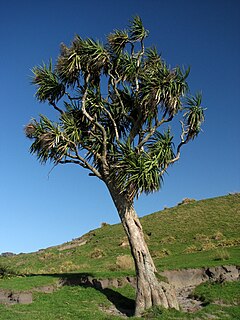
Cordyline australis, commonly known as the cabbage tree, tī kōuka or cabbage-palm, is a widely branched monocot tree endemic to New Zealand.

Podocarpus is a genus of conifers, the most numerous and widely distributed of the podocarp family, the Podocarpaceae. The name comes from Greek πούς + καρπός. Podocarpus species are evergreen shrubs or trees, usually from 1 to 25 m tall, known to reach 40 m (130 ft) at times. The cones have two to five fused cone scales, which form a fleshy, berry-like, brightly coloured receptacle at maturity. The fleshy cones attract birds, which then eat the cones and disperse the seeds in their droppings. About 97 to 107 species are placed in the genus depending on the circumscription of the species.

Hijiki, sometimes called hiziki, is a brown sea vegetable growing wild on rocky coastlines of East Asia.

Sargassum is a genus of brown macroalgae (seaweed) in the order Fucales. Numerous species are distributed throughout the temperate and tropical oceans of the world, where they generally inhabit shallow water and coral reefs, and the genus is widely known for its planktonic (free-floating) species. Most species within the class Phaeophyceae are predominantly cold-water organisms that benefit from nutrients upwelling, but the genus Sargassum appears to be an exception. Any number of the normally benthic species may take on a planktonic, often pelagic existence after being removed from reefs during rough weather; however, two species have become holopelagic—reproducing vegetatively and never attaching to the seafloor during their lifecycles. The Atlantic Ocean's Sargasso Sea was named after the algae, as it hosts a large amount of Sargassum.
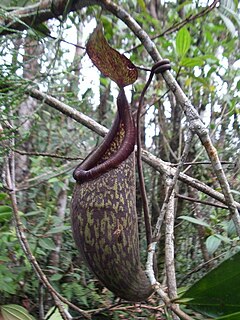
Nepenthes rigidifolia is a critically endangered tropical pitcher plant endemic to Sumatra, where it grows at elevations of 1000–1600 m above sea level.

Nepenthes papuana is a tropical pitcher plant endemic to New Guinea. The specific epithet papuana is derived from Papua, an alternative name for the island.

The sargassum fish, anglerfish, or frog fish is a frogfish of the family Antennariidae, the only species in its genus. It lives among Sargassum seaweed which floats in subtropical oceans. The scientific name comes from the Latin histrio meaning a stage player or actor, and refers to the fish's feeding behaviour.
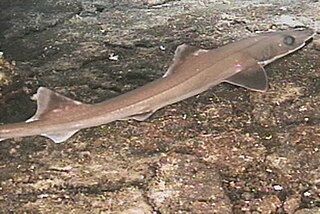
The slender smooth-hound or gollumshark is a species of ground shark in the family Pseudotriakidae. It is endemic to the waters around New Zealand, where it is usually found close to the bottom over the continental slope at depths of 300–600 m (980–1,970 ft). An extremely slim, plain brownish shark reaching 1.1 m (3.6 ft) in length, the slender smooth-hound can be identified by its broad, flattened head with a long, distinctively bell-shaped snout. Its mouth is angular with short furrows at the corners, and contains a very high number of tooth rows in both jaws. Its two dorsal fins are roughly equal in size.

Elingamita is a genus in the plant family Primulaceae. It consists of a single species, Elingamita johnsonii, a tree or shrub endemic to the Three Kings Islands approximately 55 km north of the North Island of New Zealand. The entire world natural population of the tree is confined to a small rocky island and two nearby islets, and thus is vulnerable to destruction by fire or other unforeseen events. Elingamita johnsonii grows as a shrub or small tree in pohutukawa forest and coastal scrub on West island. It also occurs on two rocky islets of the Princes Group; on one of these islets, Hinemoa Rock, it grows as an emergent canopy tree in exposed places. The relationship of Elingamita to other genera of the Primulaceae remains to be properly established. Discovered in 1950, Elingamita johnsonii takes its name from the steamer Elingamite, which was wrecked on West Island in 1902. The natural range is currently free of rodents, but the fruit is known to be very palatable to rats.

Pennantia baylisiana, commonly known as Three Kings kaikōmako or kaikōmako manawatāwhi (Māori), is a species of plant in the family Pennantiaceae. It is endemic to Manawatāwhi / Three Kings Islands, around 55 kilometres (34 mi) northwest of Cape Reinga, New Zealand. At the time of its discovery just one plant remained. This single tree grows on a scree slope inaccessible to browsing goats, and has been called "the world's loneliest tree". The species was discovered in 1945 by botanist Geoff Baylis and described in 1948, although it took decades before it was it was fully accepted as a distinct species of Pennantia. Although the only wild tree is female, it was successfully propagated from cuttings in the 1950s, one of which was induced to self-pollinate in 1985. Subsequent seed-grown plants have themselves set seeds, and the species has been replanted on the island, the adjoining mainland, and in public and private gardens around New Zealand.
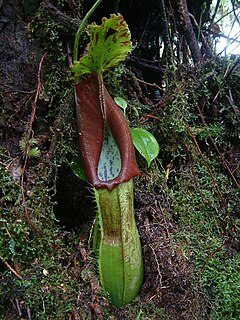
Nepenthes naga is a tropical pitcher plant endemic to the Barisan Mountains of Sumatra. It is characterised by a forked sub-apical appendage on the underside of the lid and an undulate lid margin. The specific epithet naga is the Indonesian word for "dragon" and refers to the distinctive lid appendage of this species as well as the large size of its pitchers. The name also references local folklore, which tells of dragons occurring in this species's habitat in the past.

Sargassum muticum, commonly known as Japanese wireweed, is a large brown seaweed of the genus Sargassum. It is an invasive seaweed with high growth rate. It has an efficient dispersion thanks to its floats.
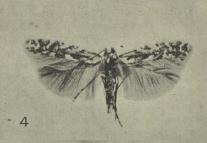
Acrocercops panacivermiforma is a moth of the family Gracillariidae. It is known from New Zealand.
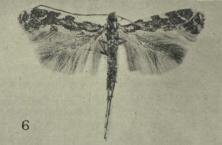
Acrocercops panacifinens is a moth of the family Gracillariidae. It is known from New Zealand. In 2019 Robert Hoare proposed that this species be provisionally assigned to the genus Eumetriochroa. However as this proposal needs further investigation this species is also currently known as Eumetriochroa (s.l.) panacifinens.

Nepenthes leonardoi is a tropical pitcher plant known from a single locality in central Palawan, the Philippines. It is closely allied to several other Palawan endemics, including N. deaniana, N. gantungensis, and N. mira. The traps of this species reach at least 24 cm in height. Some specimens are noted for producing very dark, almost black, upper pitchers.

Acacia johnsonii, commonly known as gereera wattle or geereva wattle, is a shrub belonging to the genus Acacia and the subgenus Phyllodineae that is native to parts of eastern Australia.

Veronica jovellanoides, commonly known as Riverhead speedwell, is a threatened flowering plant in the family Plantaginaceae. Endemic to New Zealand, only three plants are known in the wild. All are found within the Ernest Morgan Reserve, a 20 ha forest northwest of Auckland. Its discovery is accredited to a retired plant nursery owner, Geoff Davidson, who organised the land's protection a few decades prior, and found it by chance on a walk in November 2007.

















